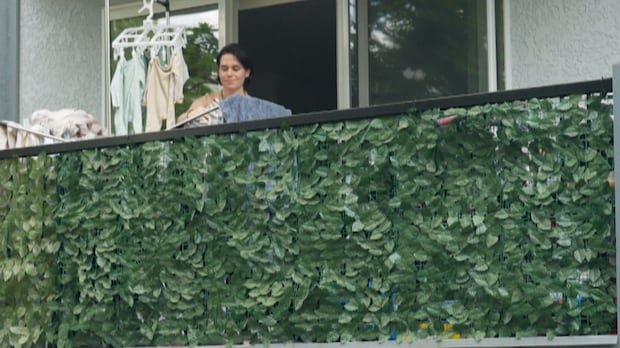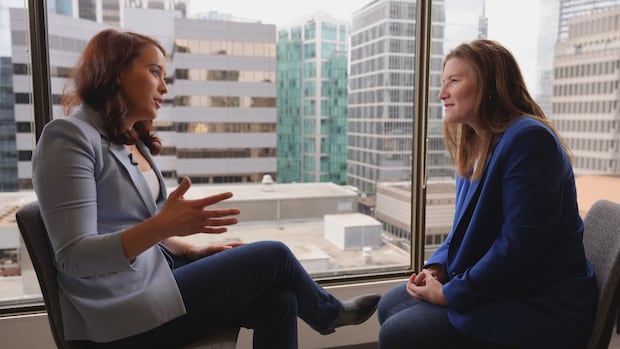Non-profits are racing to save affordable apartments. But critics say we should just build new ones
B.C. earmarked $500M so not-for-profits could buy rental units and keep them affordable

Marleny Ozuna Felix seems to have won the lottery of landlords.
For as long as she stays in her building, the single mother of three has a guarantee that her home will remain affordable.
She pays $964 per month for a one-bedroom apartment in Burnaby, B.C. — roughly $1,390 cheaper than the average rent for a unit that size in the area. Depending on the maintenance needs of the building, there will be years her rent doesn't increase. And in the years it does, it will never exceed provincial guidelines.
When her building went up for sale, chances were high a for-profit landlord would purchase it, be it a small private equity firm or a large corporation whose focus is to make a return for investors.
Instead, the new owner is Aunt Leah's Properties, a not-for-profit organization whose main objective is to keep rent accessible and to preserve what's left of Canada's affordable housing. It bought the building with a grant from a new provincial program with a similar objective.

"I would be out on the streets with my children if we were evicted from here," Felix said in a recent interview with CBC. "I just can't afford anything else that I see on the market in this neighbourhood or anywhere else."
Her story mirrors that of renters across the country who have seen record-breaking increases, while those in below-market units live with the constant fear of eviction so their landlord can relist their home at a higher price or demolish it to build a bigger building.
But this story is more than just Felix's. In many ways it's the story of the building — and whether it could be a model of how this country tackles the affordable housing crisis. While many market analysts suggest the solution is to build more housing, others argue that government funding and not-for-profits can help fill the gap by conserving existing affordable housing stock.
In the 1990s, the government largely got out of subsidized housing and turned the bulk of housing over to the private sector. Since then, private landlords have been the primary buyers and developers of new stock. They've also sometimes taken the blame for the lack of affordable housing while the government has taken a back seat.
The Ontario Non-Profit Housing Association estimates community housing accounts for about 12 per cent of overall rental housing in Canada — and non-profits own only a portion of that.
But the tide is changing, at least in B.C.
The B.C. Rental Protection Fund was announced in 2023 and has a goal of investing $500 million to help not-for-profits buy existing, occupied buildings.
"The most affordable housing we have is the affordable housing we've already got," said Katie Maslechko, CEO of the Rental Protection Fund. "We were losing four to five affordable units for every one new unit that we were building."
How it works
Not-for-profits can apply to the fund for a one-time, non-repayable capital grant to help with the purchase.
Once an organization has pre-qualified, Maslechko said they can start shopping. The grant program turns the building into a sort of rental time capsule — the rent for each unit stays the same as it was at purchase, unless there are significant maintenance costs or other factors. Then, the increase would go no higher than a few percentage points, whatever annual cap set by the provincial program.
It offers stability not only for the tenants living there, but also keeps rent from skyrocketing if there's turnover — unlike the private sector where there is no rent cap on apartments that become vacant.

This model can fill a gap for middle-income renters, Maslechko said.
"The teachers and nurses and people that make our communities run but are so often left behind by everything else out there," she said. "They often make a little bit too much to qualify for subsidized housing. And you also see that with folks on a pension, they make just a little bit too much."
Last spring, the Liberal government announced the Canadian Rental Protection Fund, which would operate similarly to one in B.C. It's still in the early stages and has yet to contribute to any acquisitions.
A spokesperson for Housing, Infrastructure and Communities Canada told CBC it would be accepting applications from housing providers until the end of May.
The national fund has a budget of $1.47 billion, with $470 million allotted for non-repayable grants and $1 billion in low-interest loans to "support the acquisitions of existing, privately owned, multi-unit residential buildings.
The CEO of the Ontario Non-Profit Housing Association estimates that budget could save up to 10,000 affordable units in two years.
Marlene Coffey said not-for-profits who have been in this business know how to preserve the existing affordable housing stock.
"We know where it's being lost and we know where we would protect it," she said. "Also if we own the asset we can leverage that through financing, so it's in our interest to grow our portfolio and leverage that asset and do more, so there is a domino effect in this strategy."
A big impact
In 2022, not-for-profits in British Columbia made just two per cent of multi-family purchases in the province. But last year, because of the provincial fund, they bought about a third of multi-family properties that came up for sale — more than a 30 per cent increase.
"Not-for-profits have never really been able to compete against big corporate landlords because they simply do not have the funding," Maschleko said. "We're changing that."
According to housing and policy expert Steve Pomeroy, the most recent census data had shown Canada lost more than 550,000 affordable housing units between 2011 and 2021. The units themselves are still there — they are just no longer affordable.
"The phrase affordability can be defined in many different ways — there is a wide range between someone who can afford three or four hundred dollars a month to someone who can afford three thousand a month," Pomeroy said, noting that Statistics Canada defines it as having housing costs that take up no more than 30 per cent of the household's gross income.
To put it in perspective, right now the national average rent for a one-bedroom unit is about $2,200 per month. So, to meet the Statistics Canada definition, he said, the household would need to make at least $88,000 a year.

Working against the housing crisis?
But not everyone believes that conservation is the way forward.
"It sounds good on paper, but in reality is actually a terrible idea," said Andrey Pavlov, a professor in real estate finance at Simon Fraser University in Vancouver. "It is better to take the money and throw it in the ocean."
Instead, he said all government funding should go toward new builds, not purchasing existing buildings.
"If you protect a building that is three storeys instead of tearing it down and building it to be 30 storeys, you are actually working against the housing crisis," Pavlov said. "We need to build a lot more. We're not keeping up with our own population growth, let alone people who want to come here."
And he said the national fund will make it harder for Prime Minister Mark Carney to fulfil his promise to build 500,000 more units a year.
To build that many units, you "need the land to build on in areas where people want to live," Pavlov said. "This fund is protecting small-scale buildings that in many cases could offer an opportunity to go much higher."
Several buildings the B.C. fund has helped non-profits acquire have already generated criticism for preserving low density in areas that need it to be much higher.
Now is better
But for Maschleko the B.C. fund is one part of fixing the housing crisis — and she said it's a no-brainer.
"It is much more cost-effective to maintain the affordability that already exists than to try to recreate it once it has been lost," she said.
She points to the high cost of building, suggesting that the only way to keep new units affordable is for the government to keep subsidizing those tenants.

"You're spending significant public money year over year to keep that affordability low versus being able to make this one-time investment," she said.
Coffey also agrees it can't be the only approach, but that rental protection funds within all levels of government are necessary.
"In the climate of tariffs we can pick up an asset at about half the price of building something new," Coffey said. "We need a multi-pronged approach to driving solutions to this housing crisis, that is how we will get there faster."



